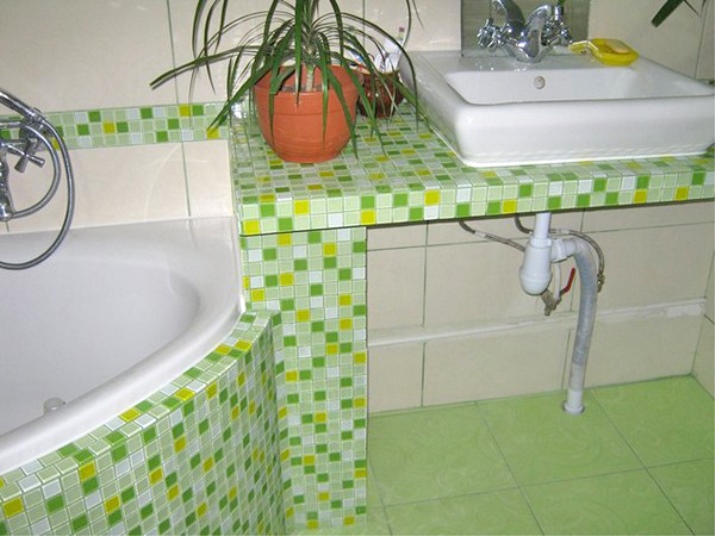Tile countertop

Beautiful and quality countertop helps to create a special atmosphere in any interior. It makes it more cozy, homely, gives a sense of finality and harmony. It is a very practical and functional decorative element. It can be solid, but more original and unusual looks countertop, lined with ceramic tiles into even rectangles or squares of different sizes.
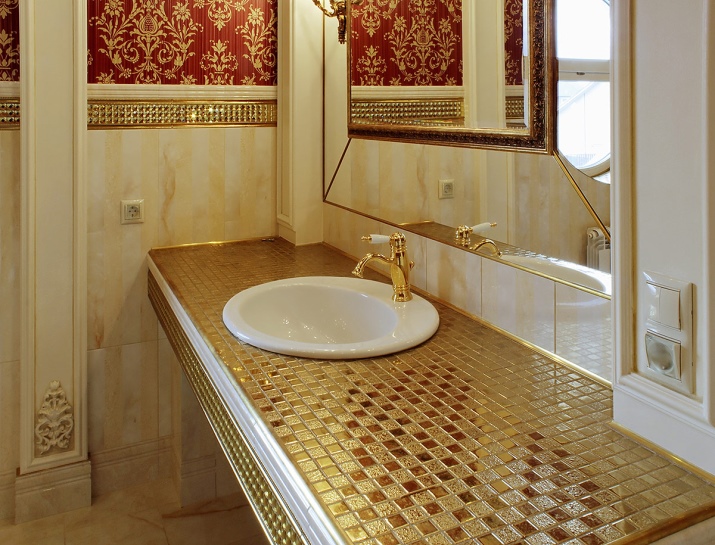
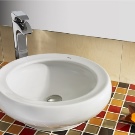
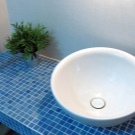
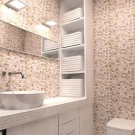

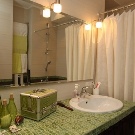
Pros and cons
Like any material, ceramic has certain advantages and disadvantages (compared to counterparts):
- Affordable price. Not everyone can afford to order a countertop of natural stone or marble, and the tile can be an excellent alternative to these materials.
- Universality. Ceramic tile looks great in interiors, sustained in all kinds of style trends: from classic to modern. Not all materials have this property.
- Practicality. Tile has high water resistance, strength, durability, resistance to mechanical stress, the action of abrasive cleaning agents and temperature fluctuations. It is easy to care for, easy to clean and wash.
- Assortment. Not every finishing material is presented today in such a huge range as ceramics. The variety of shapes, sizes, textures, colors and prints allows you to create truly unique interiors.
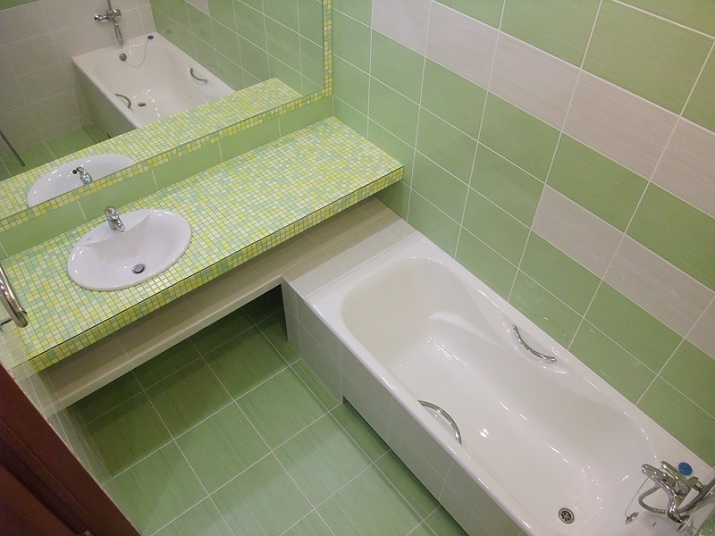
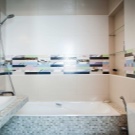
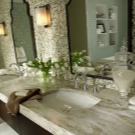
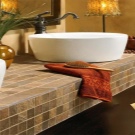
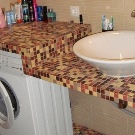
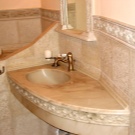
Type
Tiles can be divided into different groups - depending on the material used for its manufacture, size, shape and other parameters.
Most often, tile tiles of different sizes, glass or ceramic mosaics, pebbles and porcelain tiles are used to decorate the countertop.
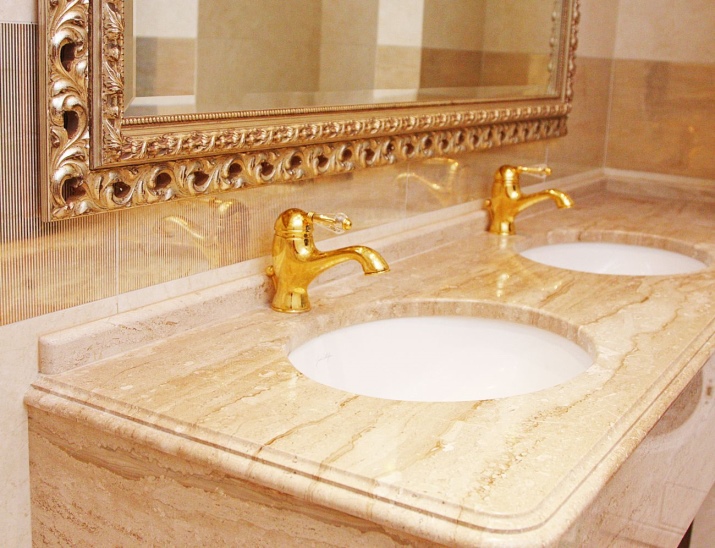
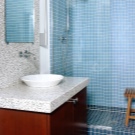
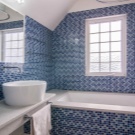


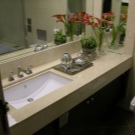
These are the most durable, durable and practical options, which have excellent decorative properties.
The choice of a suitable design variant depends on the interior of the bathroom itself, the compatibility of finishing with the main material, taste and financial capabilities of the owners.
Ceramic tile is one of the most popular and favorite finishing materials. The optimal price-quality ratio allows you to decorate the interior of any room in a fashionable and modern way without affecting the family budget.
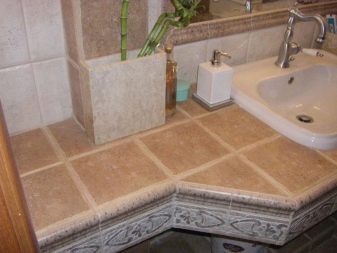
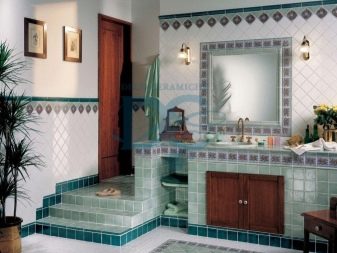
Porcelain stoneware is more expensive, but its performance characteristics are noticeably higher than conventional ceramics. In resistance to abrasion and mechanical stress, it is close to natural stone. The material has a high degree of water resistance and resistance to temperature fluctuations.
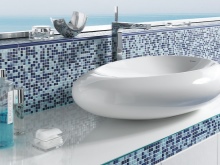

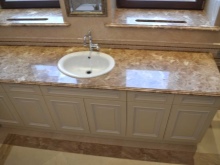
Mosaic is the most original of the proposed options, but also the least practical. Mosaic requires a certain care so that its decorative appeal was preserved for many years. In addition, and the process of laying a mosaic more time consuming and energy consuming.
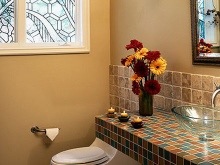
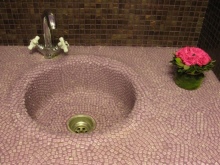
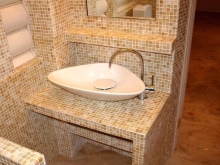
Tabletop can have different types of coating (depending on the selected material):
- Relief, textured surface. Such a tabletop looks very original and interesting, but it is also more difficult to care for. Dirt and dust get clogged in the pores, and it is not easy to clean them out.
- Smooth surface (polished or semi-polished). A classic design option, easy to care for and perfectly matches any interior stylistic solution.
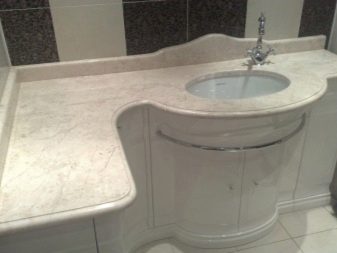
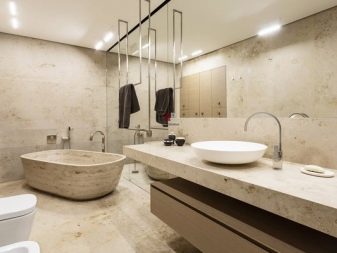
Sizes
The choice of material size depends on several parameters. First, from the size of the bathroom itself. If it is quite spacious, then the tiles can have large dimensions: 30×30 cm - 60×60 cm. Such tiles and lay easier, and take care of them easier.
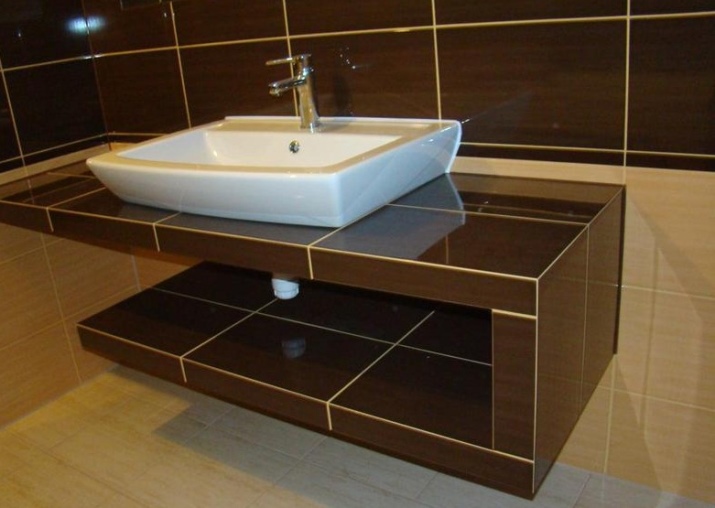
Most often, tiles of small size (10×10 cm, 15×15 cm, 20×20 cm) or mosaic are used for tiling the countertop. Small tiles allow you to visually increase the size of the room itself. And it looks in a small room more appropriate than large blocks of ceramic.
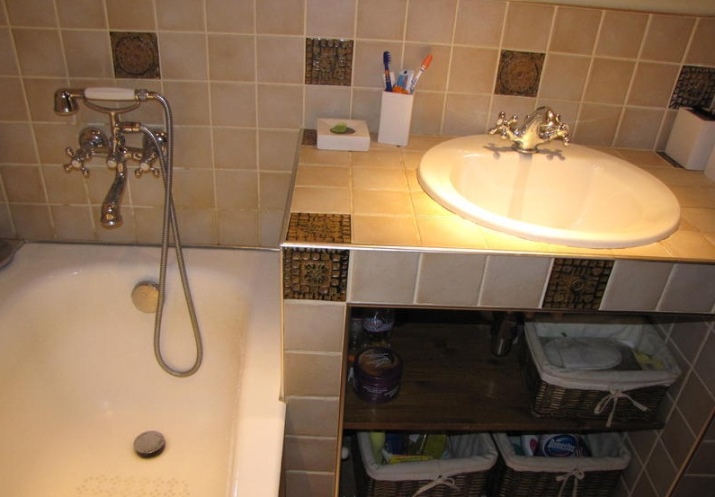
Color solution
The color range of ceramic tiles, porcelain tiles and mosaics for decorating the countertop knows no limits. The variety of shades and prints allows you to easily choose the right option for your interior.
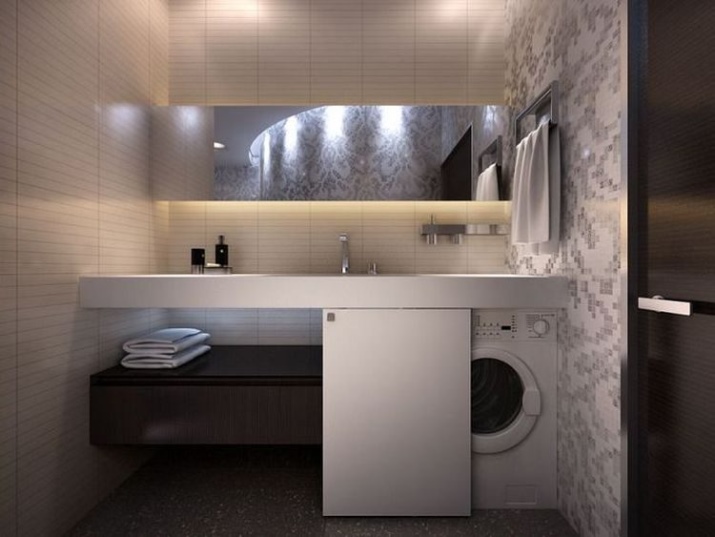
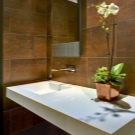
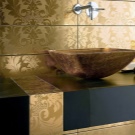
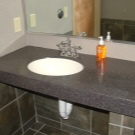
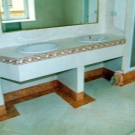

Very popular colors for many years are white, blue and all its shades. The marine theme has always been and remains one of the most popular for the interior design of the bathroom. This includes shades of turquoise, azure, sea wave and other delicate or saturated colors. The countertop can be in tone with the main interior, be a few shades darker, or completely contrasting.
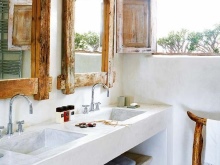
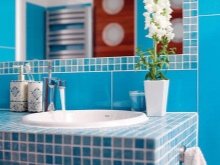
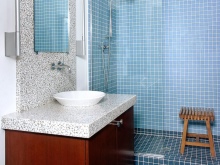
Different shades of beige, sandy, gray and black are considered more practical and neutral options. Such a range perfectly harmonizes with other colors and is appropriate for any stylistic solution of the room.
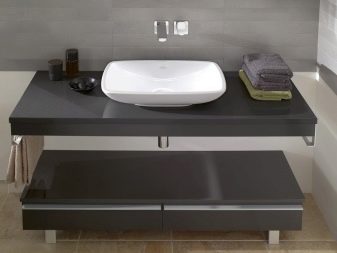
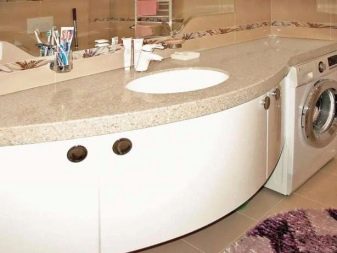
The tabletop can be performed in a monochrome version or in a combination of several close colors or contrasting colors. The combination of black and white, white and blue, red and black and other colors looks great.
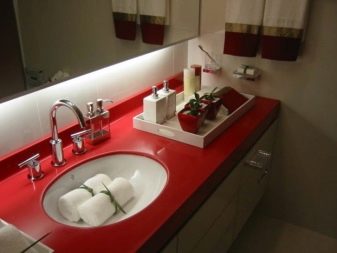
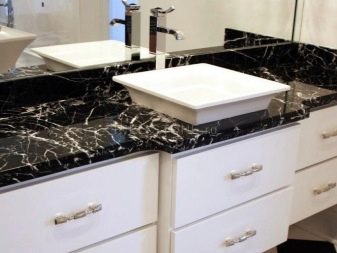
Table tops in bright colors are usually designed to match the tone of the interior. If the room is decorated in a combination of white and lilac colors, the countertop can have a rich purple hue.
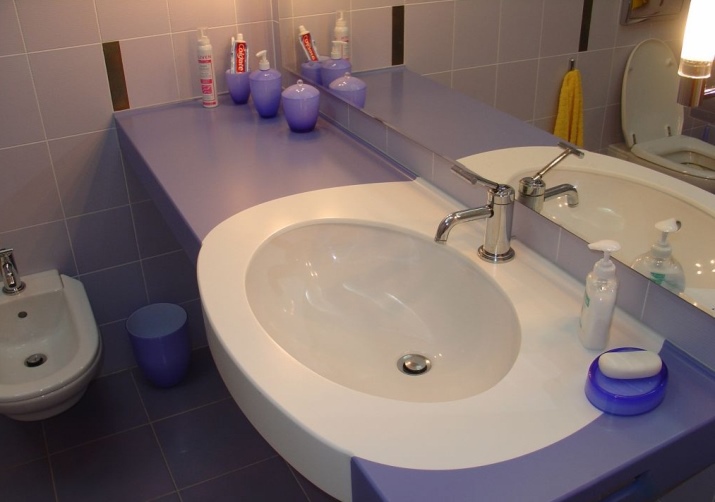
As for the choice of a pattern or print to decorate the countertop, one of the most popular options is considered a mosaic canvas, made in two or more contrasting tones. Multicolored squares form a beautiful and very original canvas.
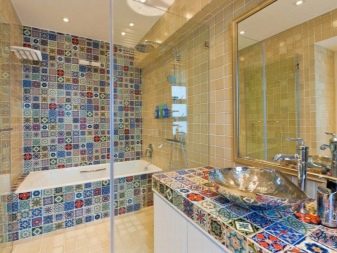
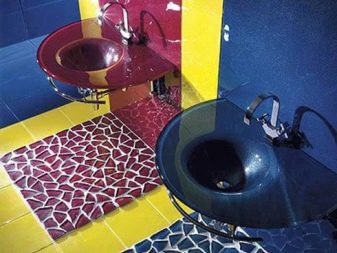
Another popular option is a plant pattern. Usually the countertop is decorated in the tone of the decorative tiles that are used to complement the interior.
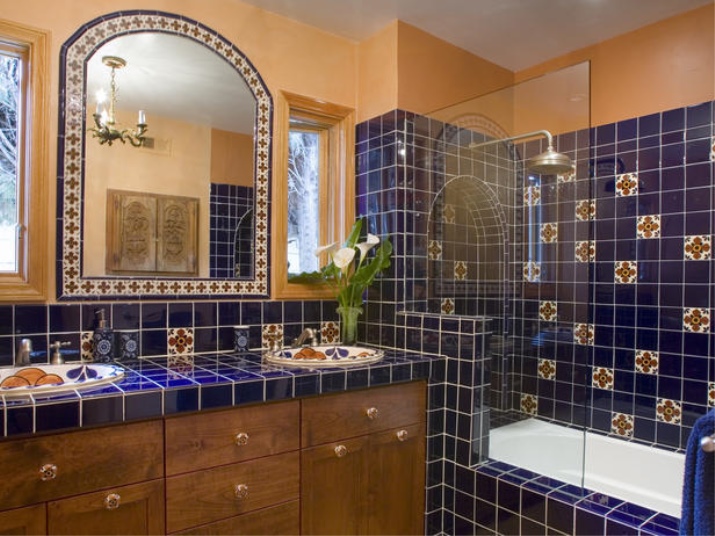
How to make the cladding?
Decorate your bathroom with an interesting and functional countertop is quite possible by yourself, without the help of professional builders. Depending on the material from which the frame and decorative design are made, the following materials and tools may be needed for the work: plywood, special adhesive, sheets of moisture-resistant gypsum board, strips of tape and self-tapping screws. The procedure is as follows:
- In the first stage of making a tabletop, you need to carefully measure the dimensions of the room and think about the design of the future element (taking into account its design features). The base for the tabletop must be very strong, so as a material for it is usually used moisture-resistant plywood.
- The next step: two blanks are sawn from plywood, which will become in the future the basis of the tabletop. They can have a classic rectangular shape or more complex. The height of the countertop depends on the size of the room, the size of the sink and the convenience of use. The optimal variant - 0,9 m.
- Blanks are glued together and additionally fixed with self-tapping screws, forming a rigid frame.
- A thin layer of tile adhesive is applied to the surface of the base and the drywall is placed. For a more secure fixation, the sheet is additionally fastened with self-tapping screws. The edges of the countertop are decorated with narrow plasterboard strips.
- Plasterboard connections are glued with gypsum sealant tape.
- A thin layer of tile adhesive is applied to the surface of the plasterboard, and tile, mosaic or porcelain stoneware is placed.
- After laying a tiled surface, the joints between the tiles are carefully grouted.
- Then the excess glue is removed, and the surface is wiped until it shines.
- The tabletop is fastened with corners.
- The sink is installed. For maximum tightness, the joints between the countertop and sink are treated with sealant.
See more details in the video below.
If the countertop is a multi-level construction, and ceramic granite is used for facing, it is best to entrust the work process to professional finishers, as incorrectly cut or laid slab will crack, crumble, and the end result will be far from the intended.
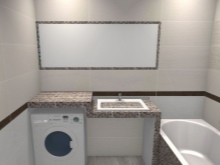
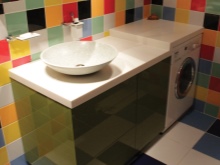
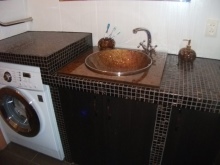
Laying mosaics
With the laying of the mosaic may have certain difficulties for a person who has no experience with it. To the finished surface does not disappoint, it is sufficient to adhere to the technology of laying. For the work will need a special adhesive on a waterproof basis and a notched spatula.
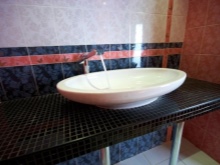
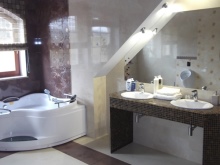
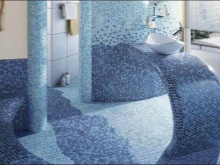
For laying mosaic, it is best to use the technology "seam to seam". Facing begins from the wall and continues to the edge of the surface. The mosaic is evenly and tightly laid on the surface pre-treated with adhesive. To decorate the narrow edge, you can use either scraps of the main coating, or special edging. The protective layer that covers the mosaic is removed after the glue dries. Then the joints are grouted, and the surface is cleaned.
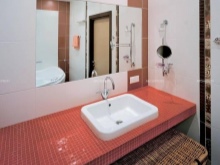
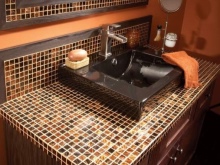
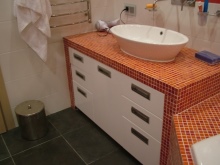
Examples in the bathroom interior
The original shape of the multilevel tabletop requires a lot of work in the manufacture and design, but the result is worth it! The two-tiered base is used both as shelves for necessary small things, and as a supporting countertop for the sink. Rectangular ceramic tiles in a beautiful gray color, which perfectly harmonizes with the interior of the bathroom, were chosen for the lining.
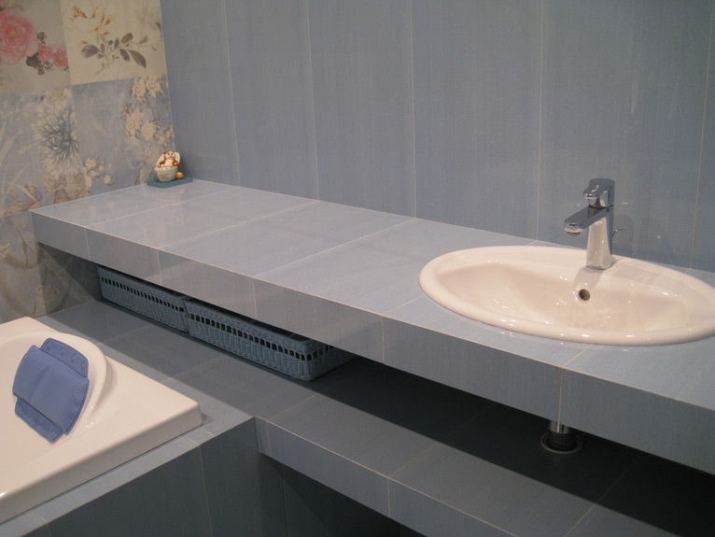
Modern room in the antique style. The interior is designed in golden and beige tones. Several different textures of materials - including mosaics - were used simultaneously to decorate the room. The rectangular tabletop is a continuation of the wall (its protruding part). The clever design allows you to use this surface as a shelf for shower accessories.
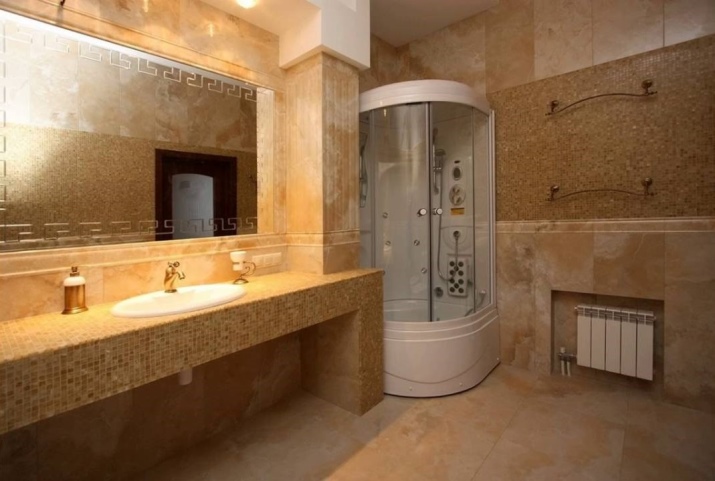
Cute mosaic, made in different shades of green, looks great as a decoration of the countertop, as a cladding of the protective screen for the bath, and as a decorative element on the walls. This color solution goes well with milky colored tiles and green floor porcelain tile.
